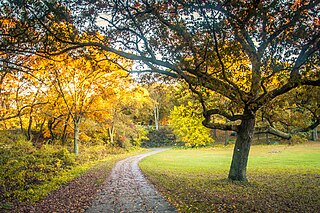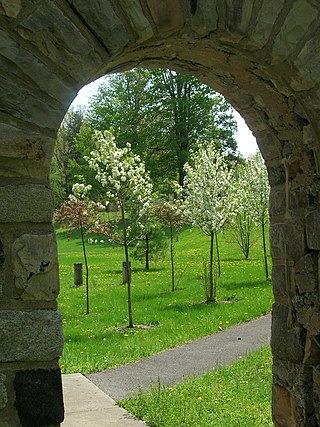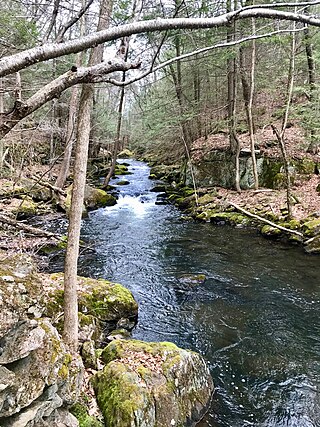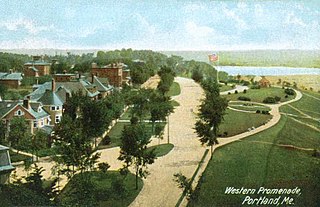
Volunteer Park is a 48.3-acre (19.5 ha) park in the Capitol Hill neighborhood of Seattle, Washington, United States.

An urban park or metropolitan park, also known as a city park, municipal park, public park, public open space, or municipal gardens (UK), is a park or botanical garden in cities, densely populated suburbia and other incorporated places that offer recreation and green space to residents of, and visitors to, the municipality. The design, operation and maintenance is usually done by government agencies, typically on the local level, but may occasionally be contracted out to a park conservancy, "friends of" group, or private sector company.

Washington Park is a neighborhood and public urban park in Denver, Colorado. The Washington Park is a blend of historic and contemporary styles of architecture. The park was first developed by Architect Reinhard Schuetze in 1899. Its design was influenced by city planner Kessler, the Olmsted Brothers and philanthropist Margaret "Molly" Brown. The park is popular with both tourists and area residents, with some comparing it to New York City's Central Park. Apart from activities such as walking, biking or volleyball, the park serves as a center for community gatherings, such as the annual Furry Scurry. Wedding receptions are often held in the historic boathouse pavilion. In 2012 the American Planning Association designated the park one of its “Great Public Spaces in America”.

Franklin Park, a partially wooded 527-acre (2.13 km2) parkland in the Jamaica Plain, Roxbury, and Dorchester neighborhoods of Boston, Massachusetts, is maintained by the City of Boston Parks and Recreation Department. It is Boston's biggest park and the site of Franklin Park Zoo. It was designated a Boston Landmark by the Boston Landmarks Commission in August 1980.

Hillside Cemetery is located on Mulberry Street in Middletown, New York, United States. Opened in 1861, it was designed in the rural cemetery style by Calvert Vaux and Frederick Law Olmsted, later noted for their collaboration on Central Park. There are several thousand graves, some with excellent examples of 19th-century funerary art.

The Newton City Hall and War Memorial is a historic city hall and war memorial building located in the village of Newton Centre in Newton, Massachusetts. Built in 1932 in the Colonial Revival style, the building was designed by Allen and Collens, with landscaping by the renowned Olmsted Brothers. The building's purpose was to serve as a new city hall, and as a memorial to the city's soldiers of the First World War. On February 16, 1990, it was added to the National Register of Historic Places.

Whitman Park is a historic park near the center of the town of Whitman, Massachusetts. It is bounded by Maple Street and Park, Whitman, and Hayden Avenues. The park was established in 1880 by a gift of land from Augustus Whitman, whose family gave the town its name. The well-known Olmsted Brothers landscape firm was retained to design a public park on this land, which was implemented in 1900. This gave the park the basic layout of its paths, as well as its general appearance as a woodland park with open fields for passive recreation. Features that were part of the Olmsted design include a wading pool, concrete tennis court, bandstand, and a drinking fountain. The Olmsteds were retained again in 1931 to update the design, accounting for the addition in 1908 of the Civil War monument, and to deal with problematic drainage of water from the park's low-lying areas. The major intrusion on the Olmsted design has been the construction of a Little League ballfield in one corner.

Pulaski Park is a city park along the Connecticut River in Holyoke, Massachusetts. Originally called Prospect Park when it was laid out in 1884, it was given its present name in 1939 in honor of American Revolutionary War hero Casimir Pulaski, for whom there is a memorial in the park's center. The original 5.1-acre (2.1 ha) park was designed by the Olmsted Brothers landscape design firm.

The Middlesex Fells Reservoirs Historic District is a historic district roughly bounded by Pond St., Woodland Rd., I-93, and MA 28 in Stoneham and Medford, Massachusetts. It encompasses a portion of the Middlesex Fells Reservation, a state park managed by the Massachusetts Department of Conservation and Recreation (DCR). The principal features of the district are three reservoirs and their associated gate houses and pumping stations, which were developed by the Metropolitan District Commission starting in the late 19th century. The district was listed on the National Register of Historic Places in 1990.

Hammond Pond Parkway is a historic parkway in Chestnut Hill, Massachusetts. The road, built in 1932, extends 2 miles (3.2 km) from Hobart Road in Newton to Horace James Circle in Brookline, where it joins the West Roxbury Parkway. It was designed by Charles Eliot and the Olmsted Brothers to provide a parkway setting that provided access from Brookline, Newton, and the western portions of Boston to the southern parks of the Emerald Necklace. The parkway was listed on the National Register of Historic Places in 2004.

Utica Parks and Parkway Historic District is a national historic district located at Utica in Oneida County, New York. It consists of four contributing historic elements: a historic right-of-way known as the Memorial Parkway and the three large parks it connects: Roscoe Conkling Park, F.T. Proctor Park, and T.R. Proctor Park. The district includes seven contributing buildings, three contributing sites, 26 contributing structures, and five contributing objects. The park and parkway system was designed between 1908 and 1914 by the firm of Olmsted Brothers Landscape Associates, headed by Frederick Law Olmsted Jr. The Utica Zoo is located in Roscoe Conkling Park.

Laurelhurst Park is a city park in the neighborhood of Laurelhurst in Portland, Oregon. The 26.81-acre (10.85 ha) park was acquired in 1909 from the estate of former Portland mayor William S. Ladd. The City of Portland purchased the land in 1911, and the following year park superintendent Emanuel Mische designed the park in accordance with the Olmsted Plan.

The Williams Memorial Park Historic District is located in New London, Connecticut, roughly bounded by Hempstead, Broad, Mercer and Williams Streets, with houses on Broad Street south to Cottage Street included. Williams Memorial Park – which was designed by Frederick Law Olmsted – is also included, as is the Civil War monument located there; 16 houses are part of the district, while two buildings – a brick office building at 43 Broad Street and an apartment building at 127 Hempstead Street, are non-contributing properties. Four of the six outbuildings in the district are contributing. Nine different architectural styles are represented in the district.

The 'Hancock Brook Trail' is a 2.8-mile (4.5 km) Blue-Blazed hiking trail Waterville Section of the City of Waterbury in New Haven County close to the borders of Thomaston and Plymouth, Litchfield County, Connecticut. It is contained overwhelmingly in a section of the Mattatuck State Forest bounded by Hancock Brook on the east, Thomaston Avenue on the west and Spruce Brook Road / Route 262 to the north.

Tracy S. Lewis was a principal and founder of the Beacon Falls Rubber Shoe Company, which dominated the economy of Beacon Falls, Connecticut during the first decades of the 20th century. The Tracy S. Lewis House is the home he built and lived in Beacon Falls. There is currently a debate over the town's decision to raze the house.

The Western Promenade is a historic promenade, an 18.1-acre (7.3 ha) public park and recreation area in the West End neighborhood of Portland, Maine. Developed between 1836 and the early 20th century, it is one Portland's oldest preserved spaces, with landscaping by the Olmsted Brothers, who included it in their master plan for the city's parks. The promenade was listed on the National Register of Historic Places in 1989.

The High Street Historic District encompasses a well-preserved 19th-century residential area of Camden, Maine. Extending along High Street, the district has maintained its character since the 1920s, despite encroaching commercialization of nearby areas, and retains a cross-section of architecture of the 19th and early 20th centuries. It was listed on the National Register of Historic Places in 1989, and enlarged in 1999 to include the Olmsted Brothers-designed Harbor Park at Main and Atlantic.

Walnut Hill Park is a large public park west of downtown New Britain, Connecticut. Developed beginning in the 1860s, it is an early work of landscape architect Frederick Law Olmsted, with winding lanes, a band shell, and the city's monument to its World War I soldiers. The park was listed on the National Register of Historic Places in 1982.

Hamilton Park is the oldest city park in Waterbury, Connecticut. Founded in 1898 as a gift from the locally prominent Hamilton family, it offers both passive and active recreation, with ballfields and other amenities. It is located on 93 acres (38 ha) southeast of downtown Waterbury, accessed via entrances on East Main Street. It was listed on the National Register of Historic Places in 1996.

Riverside Cemetery is a historic rural cemetery located at 496 Riverside Street in Waterbury, Connecticut on the western bank of the Naugatuck River.






















